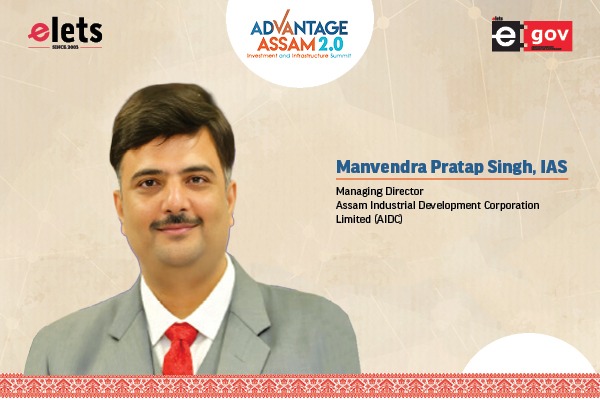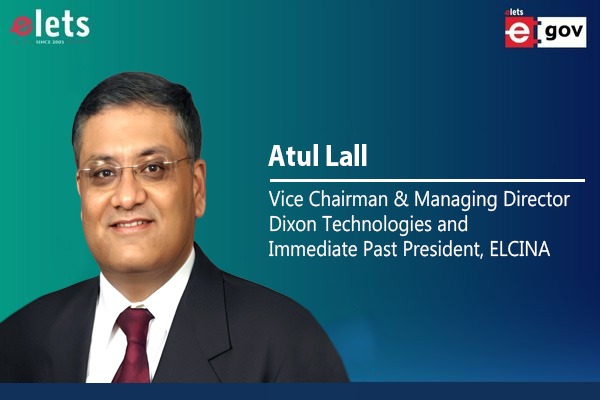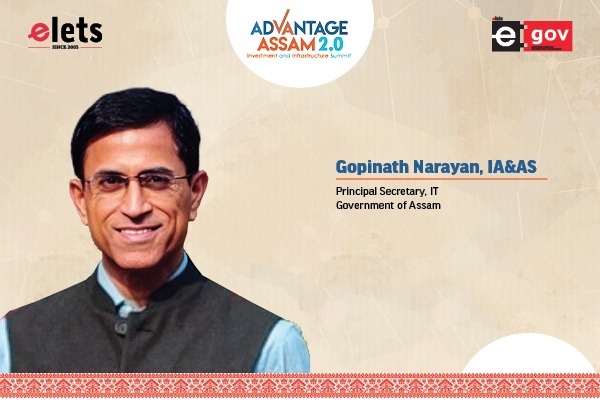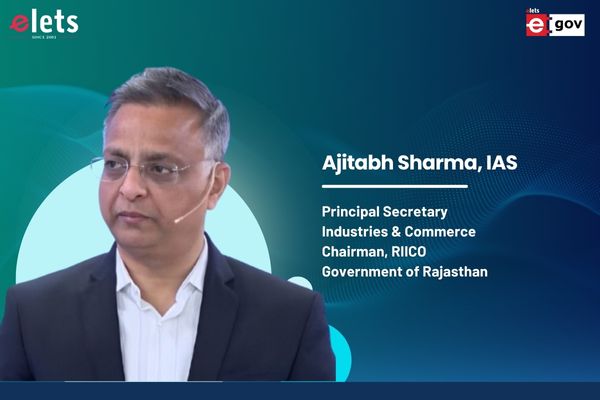
 Ariba, Inc. is the leading Spend Management solutions provider. Ariba helps companies develop and leverage spend management as a core competency to drive significant bottom line results. In today’s intensely cost-conscious environment, choosing the right spend management provider is crucial. Ariba is the pioneer and a proven leader in creating powerful Spend Management solutions for major companies worldwide—including many of the Fortune 100.
Ariba, Inc. is the leading Spend Management solutions provider. Ariba helps companies develop and leverage spend management as a core competency to drive significant bottom line results. In today’s intensely cost-conscious environment, choosing the right spend management provider is crucial. Ariba is the pioneer and a proven leader in creating powerful Spend Management solutions for major companies worldwide—including many of the Fortune 100.
In an exclusive interview with egov, T. Sivakumar, Group Director, Ariba India, provides insights about Spend Management solution, difference between the typical e-procurement approach and endto- end approach and where is Ariba placed in this entire sector.
How is the response of Indian government to the Spend Management Solution?

Excellent. In fact, I would say it is overwhelming at this point in time. We would be focusing on a couple of forward-looking state governments on this concept. They very clearly understand that this is not just e-tendering system which will give them the benefit they want. They clearly understand that the benefit in the entire approach is to really tackle not only in the tendering and sourcing stage but also right upto the procurement compliance. Till the time the buyers place the order after the contract and pay the supplier and get the services as per the contract, the cycle is not complete and the savings does not really come to the government kitty. And the transparency factor is not established right through the value chain. So, to a large extent they clearly appreciate it. The second aspect in which they clearly appreciate it in this approach is bringing in synergies across different functions in the government. They realize that there should be some synergies across the different government departments such as public health care, public works department or the education and so on, because at the end of this debate, money is going from one particular organization. And therefore, that particular conceptual approach, which we brought in, is really being taken up well by these governments.
Is Ariba trying to implement Spend Management with Andhra Pradesh, which is successfully implementing the e-procurement?

Andhra Pradesh has started with e-tendering and reverse option as they call it, as their focus, which is not Spend Management. Yes, they have got benefits. I am not denying that they have done a great job. But having said that, the whole idea of implementing Spend Management for any government is to get multitude of those benefits if you are able to attract the end-toend process. So we are not currently talking to them because they are already using something, they have a concept in mind already. Our primary focus is outside those governments that have done reverse auction or e-tendering. And that is where we actually see a huge amount of by-in from them. Here we need to give all the three things to them that they want- savings, transparency and process implementation. This end-to-end process also needs to give the huge advantage to the end customer, supplier or the citizen for that matter. So it is a huge benefit right down to the value chain, actually. And that is why we see a huge buy-in.
“Spend Management initiative will start showing results within 3-6 months of embarking on it, whereas if you look at any of their e-governance initiatives, it takes at least a year or a two for the system to be up and running before you start seeing discernible benefits out of it.”
Till now Ariba has been working with the developed nations like the US, it’s for the first time you are into a developing nation like India. What are the challenges you are facing to implement this kind of solution in India?
I completely agree to your question. But having said that we are not new in India. We have been here for the last 5 years and we are the market leader in Spend Management in the enterprise sector in India, very clearly. We do not know the estimate but we have the market share of 65-70% in that particular area. But the interesting thing is that when we move down to the government, there are new challenges that we faced in the past. One is to break the mind-set that this is not the e-tendering system. This is not a customizable system. There are some best practices, some standard methodologies that people can follow. What we see in India today is most of the governments are not benchmarking themselves across states to Andhra Pradesh, to Karnataka. They want to benchmark themselves with the best in the world. So that really opens up to the global phenomenon here. And though we have not done any work with the government in India so far, which I am sure we will be doing shortly, but the interesting thing is that most of the IT Secretaries and the Chief Secretaries are very much interested to know how they can bench mark to the best in the world. So from that perspective, I think the mindset is changing, people definitely are appreciating it.
How is the response of other Asian countries compared to India? Have you explored the market there?
Absolutely. South Asia has a year and a half advantage over India in this area. For example, there is very large installation of Ariba in South Asia. Ministry of Defence in Singapore is the best example that I can site right now, publicly disclosed example. They are saving tons of money on a monthly basis, so their response is overwhelming.
Also Read: IT accelerated judicial administration
How do you see the market for Spend Management in South Asia and India? What is your plan?
See it is an estimate, we believe that at least 20 more states would be going in for massive e-Governance project in the next 2-3 years. This is an estimate from the press reports that we gathered. It is up to Ariba to see how it can really contribute and actually go and grab in this particular market. This is a very fast growing market. The extent of benefit that these governments can get out of the procurement solution and e-governance space is probably the highest in the entire e-governance value chain because these results are very tangible. We are very comfortable to say that if the governments implement the e-governance and Spend Management properly, there is 400-500 crores of the savings up the take. So it is easy to get these numbers in on a year to year basis.
We are talking to a lot of opinion leaders apart from the IT Secretariat, the Chief Dignitaries, in the government. Second is that an enhanced focus in this sector, because we can clearly see not just the opportunity but huge value addition that we can do for our governments.
In India, the government mindset is still that they do not work on computers, so do you provide specific training on the ground, on these kinds of solutions?
I agree absolutely. To the extent of change management, you will have to do a little bit of additional work in India, there is no doubt about it. But there are two broad focused areas for both developed nations and India. For instance they also have a standard procedure for procurement like we have the CVC guidelines in India. So one, is to try and map this process, to that. The second is the extent of training and handholding and more importantly, commitment to ensure that every single spend is managed through this system. To that extent, the extent of training that you require is slightly more for the governments out here. And we are aware of this because currently we have some standard training programs both from the process side as well as in the technology side. Both are equally important. The other interesting thing on the technology side is, if you take any analysis report, Ariba has been declared as the most-user friendly system across the globe, so to that extent, a person can start working on the Ariba template after just an hour of basic training.
Do you think the National e-governance Plan is helping these kinds of solutions and the private players to work with the government and will they bring more public and private partnerships in the future?
Absolutely. It is a very good step that the government is taking. And some of the guidelines that they have put up are very interesting. They are focusing on quality, on time-bound implementation and they are clearly advising private sector. I think this is the step in the right direction.
In India, different states are moving in different directions, there is less of coordination amongst the states so how do you, as a private player, see this scenario in India, where it is heading?
See, if you look at e-governance, it is a very broad spectrum. The ‘P’ that we would be focusing in Spend Management, is procurement related, one important part of the entire project. While we clearly see there is some leaders- Andhra Pradesh, Karnataka, Tamil Nadu is very closely catching up. Rajasthan, Gujarat, in the north are catching up right now. Very clearly, there is a pack of leaders and a pack of followers right now. That will take some time, but what is noteworthy is that having seen the leaders doing certain things well and certain things not well, the followers are becoming even wiser. Yes they are definitely moving in
“What we see in India today is most of the governments are not benchmarking themselves across states to Andhra Pradesh, to Karnataka. They want to benchmark themselves with the best in the world. So that really opens up to the global phenomenon here.”
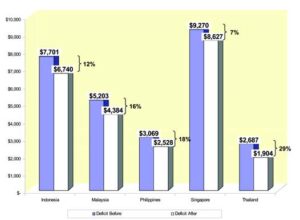 different directions but that how any country would go about. Even in the US, the situation is the same because it depends upon lot of local factors, support factors, technology adaptation factors and so on and so forth. But what is common in this, I think ‘P’ is broadly common. But yes, different governments are trying to oppose it. Some of the governments are forward looking to say look this is the concept so give me three, four or 5 years old map and take me to the end of the concept. There are some governments, that have a very short term vision, they just comply with some of the regulatory governance that they have, so they just quick-fix the solution. And there is also the classic tussle between classic solution and the western class solution. A lot of people still are very comfortable with customizing a package according to their requirement, which is not sustainable. These are some of the conceptual differences, which they still continue to have but I think that will continue to exist.
different directions but that how any country would go about. Even in the US, the situation is the same because it depends upon lot of local factors, support factors, technology adaptation factors and so on and so forth. But what is common in this, I think ‘P’ is broadly common. But yes, different governments are trying to oppose it. Some of the governments are forward looking to say look this is the concept so give me three, four or 5 years old map and take me to the end of the concept. There are some governments, that have a very short term vision, they just comply with some of the regulatory governance that they have, so they just quick-fix the solution. And there is also the classic tussle between classic solution and the western class solution. A lot of people still are very comfortable with customizing a package according to their requirement, which is not sustainable. These are some of the conceptual differences, which they still continue to have but I think that will continue to exist.
Is there any other player who has moved into the government enterprise sector, and created awareness to this end-to-end solution, apart from Ariba in India?
To the best of our knowledge, no. There are a lot of point solution providers. The majority of them are in the e-tendering and reverse option space. There are a plethora of them but to the best of my knowledge, there is none who can bring in an end-to-end concept. Because basically, they need to know Ariba and Ariba is clearly 3-4 years ahead of its competitors elsewhere not only in India but globally in terms of our conceptualization of Spend Management.
Also Read: Enforcing “rule of justice” through e-Governance
Do you find the progress slow in India as compared to other countries?
Today most of the e-governance projects are going at a brisk pace. And like private players they are working on a tight time plan. To that extent, I would partially agree with you but not totally, because right now, I clearly see a sense of urgency in many of the governments that we are talking about. They also know that this is a clear area where they can immediately get tangible benefits. This particular Spend Management initiative will start showing results within 3-6 months of embarking on it, whereas if you look at any of their e-governance initiatives, it takes at least a year or a two for the system to be up and running before you start seeing discernible benefits out of it. In this case, the service provider hosts most of the technology. It is not actually purchased by the government. So most of the governments are benefited very clearly. So I think the pace is pretty good right now.
What is Spend Management Solution?
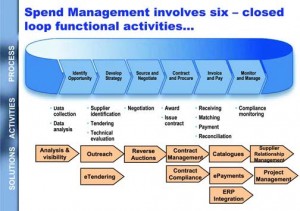 Spend Management (SM) is a new category of solutions that is designed to enhance company’s sourcing and procurement strategy. By allowing companies to combine their analysis, sourcing, contracting, procurement and reconciliation processes into a single, cohesive system, SM provides closer visibility over its spend. Spend management helps companies to efficiently manage their purchasing functions and thereby gain a competitive advantage and improve bottom line results.
Spend Management (SM) is a new category of solutions that is designed to enhance company’s sourcing and procurement strategy. By allowing companies to combine their analysis, sourcing, contracting, procurement and reconciliation processes into a single, cohesive system, SM provides closer visibility over its spend. Spend management helps companies to efficiently manage their purchasing functions and thereby gain a competitive advantage and improve bottom line results.
With the adoption of Spend Management, governments can not only save costs but also increase operational efficiency dramatically. The savings in turn will help the government to invest in other productive areas for improved and tangible returns.
Spend management also marks an evolution in egovernance with a government to Business (GtoB) approach that allows e-transaction between government agencies and private businesses. This change actually brings more accountability, transparency, and fairness to all government business transactions.
Be a part of Elets Collaborative Initiatives. Join Us for Upcoming Events and explore business opportunities. Like us on Facebook , connect with us on LinkedIn and follow us on Twitter, Instagram.
"Exciting news! Elets technomedia is now on WhatsApp Channels Subscribe today by clicking the link and stay updated with the latest insights!" Click here!




